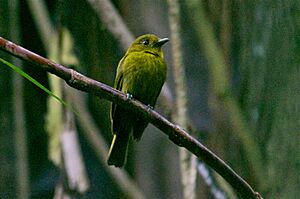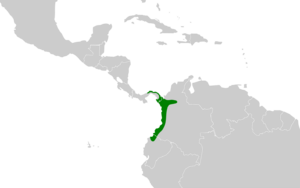Sapayoa facts for kids
The sapayoa or broad-billed sapayoa (Sapayoa aenigma) is a small, unique bird found in parts of South America, specifically Colombia, Ecuador, and Panama. It's a type of passerine bird, which means it belongs to a large group of birds often called "perching birds" or "songbirds." However, the sapayoa is a suboscine, meaning its vocal learning is simpler than that of typical songbirds.
Quick facts for kids Sapayoa |
|
|---|---|
 |
|
| Nusagandi, Panama | |
| Conservation status | |
| Scientific classification | |
| Genus: |
Sapayoa
|
| Species: |
aenigma
|
 |
|
Contents
About the Sapayoa
The sapayoa is a very special bird because scientists have long been puzzled about where it fits in the bird family tree. Its scientific name, Sapayoa aenigma, even includes the word "aenigma," which means "enigma" or "mystery."
Discovering the Sapayoa
A German bird expert named Ernst Hartert officially described the sapayoa in 1903. He gave it its current scientific name, Sapayoa aenigma. From the beginning, it was known as the only species in its group, called a monotypic genus.
For a long time, scientists thought the sapayoa was related to New World suboscine birds, like the manakins found in the Americas. But some studies suggested it might be related to birds from the Old World, like the broadbills and pittas found in Asia and Africa.
A Bird from Ancient Times
Newer research suggests that the sapayoa is indeed related to Old World birds. Scientists believe its ancestors might have traveled from what is now Australia-New Guinea to South America a very long time ago, when the supercontinent Gondwana was breaking apart. This makes the sapayoa a living link to a very ancient bird lineage.
Because of its unique history and genetic makeup, major bird classification systems now place the sapayoa in its very own bird family, called Sapayoidae. This shows how special and distinct this little bird truly is.
What the Sapayoa Looks Like
The sapayoa is a small bird, about 13.5 to 15 cm (5.3 to 5.9 in) long. That's about the length of a typical pencil. It weighs around 21 g (0.74 oz), which is about the same as a few quarters.
Its head and back are olive-green, and its wings and tail have a slightly darker, dusky color. Its throat and belly are a brighter, more yellowish-olive. The sapayoa has a wide, black beak with special stiff feathers called rictal bristles around it. Its eyes are a dull reddish-brown, and its legs are gray. Male sapayoas have a yellow stripe on the top of their heads.
Where the Sapayoa Lives
The sapayoa lives in a specific area that stretches from the Panama Canal Zone south through western Colombia and into the very northwestern part of Ecuador.
It prefers to live in humid forests, from the lower parts of the trees up to the middle levels. You can often find them in ravines or near streams and rivers. In Colombia, they can live as high as 1,200 m (3,900 ft) in elevation, but in Ecuador, they are usually found below 500 m (1,600 ft).
Sapayoa Behavior
The sapayoa is thought to live in its home range all year round. It doesn't seem to migrate.
How the Sapayoa Finds Food
The sapayoa usually hunts by sitting still for a long time on a perch. Then, it quickly flies out to catch insects in the air or pick them off leaves. It also eats small fruits. These birds often join groups of different bird species that are feeding together.
Sapayoa Reproduction and Life Cycle
The sapayoa's breeding season happens between March and September in Panama, and from February to April in Colombia.
Their nest is shaped like a pear and is made from long strips of bark and other plant fibers. Some of these fibers hang down below the nest. The nest has an entrance on the side, near the bottom. They usually hang their nests from a tree branch, often over a stream.
Scientists have found nests with two baby birds inside. In one case, both parent birds helped feed the babies. In another nest, the female bird kept the babies warm, and an adult male and two younger males helped take care of her and the young birds.
Sapayoa Sounds
Not much is known about the sounds the sapayoa makes. One sound described is a "soft trill," and another is a slightly louder "chipp, ch-ch-ch."
Sapayoa Status
The IUCN (International Union for Conservation of Nature) has listed the sapayoa as a species of "Least Concern." This means they are not currently in immediate danger of disappearing. However, their exact population size isn't known, and it's believed that their numbers might be decreasing. No major threats to the sapayoa have been identified yet. They are generally considered to be rare or uncommon, and might only be found in certain local areas.
Images for kids




